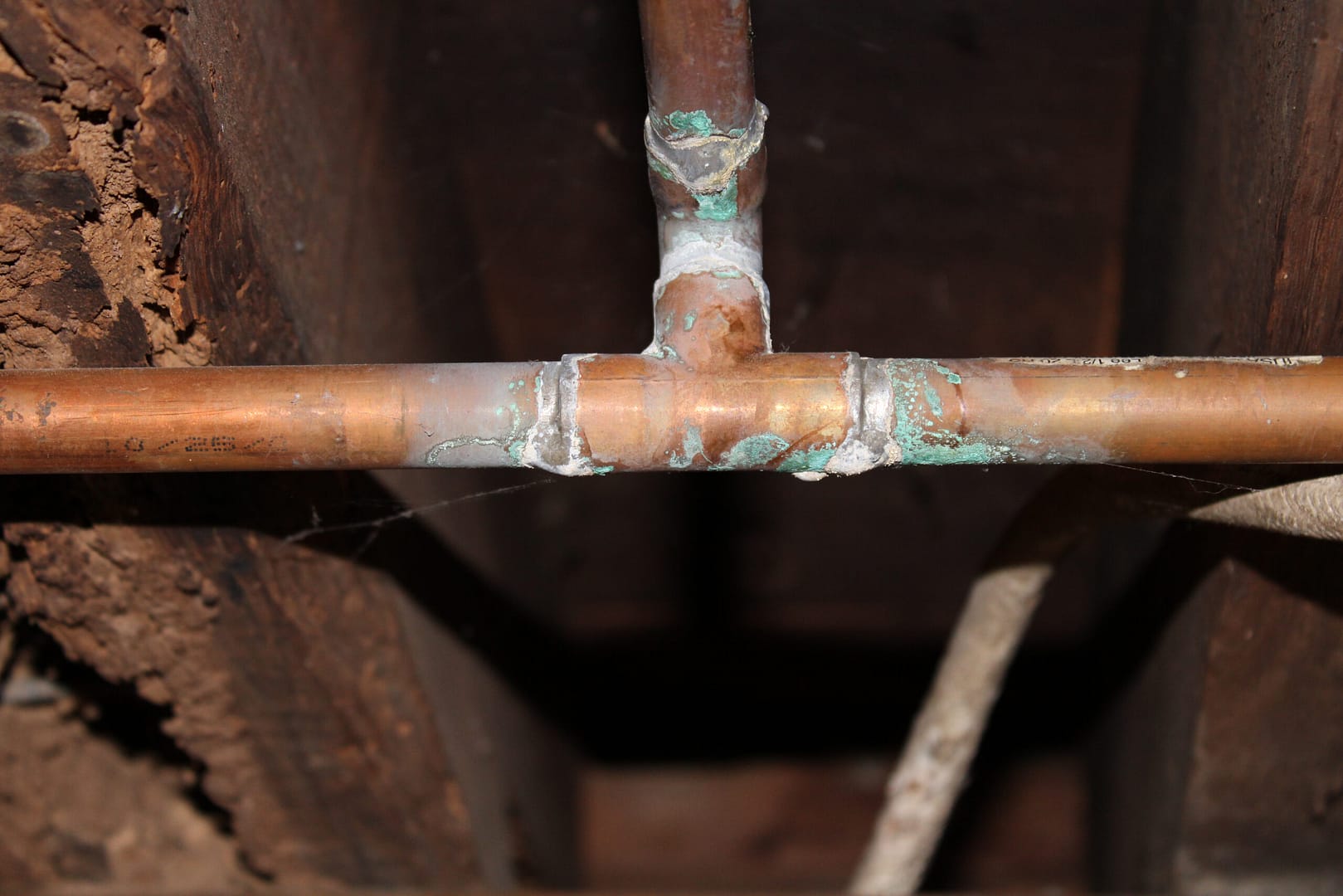Have you ever looked at an old piece of metal? They can be covered in a range of hues, rusty reds and browns, striking shades of green and blue. While this might be very pretty in a patinaed way, it’s not something you want to see when you’re looking at your plumbing. These are signs of corroded pipes and, if not dealt with, will harbinger some serious plumbing problems.
Of course, most cases of corrosion actually occur inside the pipes, that’s where the water is after all. There you won’t see the colors but might find odd tastes coming from your faucet, reduced pressure and other symptoms. But what exactly is causing this pipe corrosion and what can be done about it?
What Causes Pipe Corrosion?
Most of the materials we use for our plumbing have been chosen because they offer a mixture of resistance to chemical reactions, longevity and flexibility. Generally, your pipework should last decades without much issue. That being said, being resistant to damage and being immune aren’t the same thing.
Over time, chemical reactions such as oxidization and scaling will occur in metal pipes. Depending on the material in question this might produce rust or the distinctive green patina found on copper.
These, if allowed to progress long enough can lead to all kinds of problems. The older the pipework, the more chance of these reactions taking place on a scale that presents a problem.
Different materials are more or less reactive. For example, modern PEX pipes are made from plastic and basically will not corrode (though they can be susceptible to other kinds of damage). On the other end of the scale, older galvanized steel will start to rust as its protective layer is eroded. Copper, the other common supply pipe, sits somewhere in the middle.
Likewise, different conditions such as particularly low PH acidic water or calcium rich hard water will have a greater impact. This, coupled with external factors such as soil composition and conditions or local humidity levels can speed or slow the rate of corrosion.
Common Signs of Corroded Pipes
A little corrosion is likely present in metal pipework that’s been in place for a few years, going mostly undetected. Once it build up to noticeable levels, it’s time to act. Be on the lookout for things like:
- Discolored water: Red, brown or orange tinges to your water supply are usually signs of rust in pipes or sediment build up. Rust forms on the interior walls of your pipes (or in your water heater) and gets knocked loose by the flow of water. Sediment is formed from mineral contaminates in the water- usually these are nothing to worry about, but they can build up over time.
- Metallic taste or odor: An unpleasant taste or smell when you turn on the faucet could be a sign of pipe corrosion. Small particles of corroded pipe are breaking off and entering your supply.
- Low water pressure: Corroded pipes lose their smooth inner bore as the chemical reactions take place. Eventually, this roughness could build up to the point where it starts to restrict the flow of water through the pipe.
- Leaks and drips: As the process of corrosion weakens the structure of your pipework, holes can start to appear. These could range from tiny pinholes to full-on cracks, depending on the material and how advanced the problem is. Look for visible signs of water escaping like wet patches on walls, ceilings and under sinks.
- Noisy pipes: Generally, your supply pipes should be full of water. Corrosion can create lumps and bumps which in turn produce eddies and air pockets where water doesn’t flow properly. These might cause whistling, banging or other odd sounds as water moves past them.
- Visible rust or green residue: If you notice rust or the distinctive green patina of oxidized copper, corrosion is happening. Keep an eye on exposed pipes for these visual signs.
- Frequent Clogs: As bits of corroded pipe lose their structural integrity, they break off. Larger chunks might come loose and lodge themselves further along the corroded pipe, causing clogs.
- Rising water bills: Both water escaping in the form of leaks and inefficient flows could cause unexpected rises in your water bill. You can use your meter as a basic form of leak detection by turning off all your faucets and appliances and watching the dial.
Risks of Ignoring Corroded Pipes
While a little corrosion is to be expected, letting the situation get out of hand is a bad idea. Problems associated with rust in pipes and copper plumbing corrosion vary from the potentially expensive to the outright dangerous. Over time, small problems will progress and grow into larger ones.
Health Risks
While minor rust in water caused by corroded pipes is generally harmless for most people, advanced corrosion can lead to significant health concerns. Here’s how:
- Contaminant Introduction: As corrosion progresses, holes or cracks in pipes can allow external contaminants—such as soil, bacteria, and chemicals—to infiltrate the water supply. These contaminants can pose serious health risks, particularly for children, older adults, and individuals with compromised immune systems.
- Lead Exposure in Older Pipes: In homes with older plumbing, corroded pipes may release lead into the water if lead materials were used in the construction of the system. Lead exposure can cause developmental delays in children, neurological issues, and other long-term health complications.
- Potential for Harmful Bacteria Growth: Stagnant water trapped in corroded or damaged pipes can become a breeding ground for bacteria such as Legionella, which may lead to waterborne illnesses.
- Aesthetic and Quality Issues: Corrosion not only alters the taste and smell of your water but may also introduce discoloration, making it unappealing and raising concerns about water quality.
Taking steps to address corroded pipes is essential to ensure your water remains clean, safe, and suitable for consumption.
Structural Damage
As well as damaging your health, corroded pipes can lead to bursts and leaks, damaging your home. A burst ½ inch pipe can lose up to 50 gallons a minute, rising to up to 110 gallons with a ¾ inch pipe. It goes without saying that this can and will do significant damage to your property.
Even smaller leaks such as pinholes can cause a surprising amount of damage very quickly. Wet walls and floors can warp, foundations crack and mold will absolutely thrive in the damp conditions they cause.
If you live in an apartment, the damage might not be limited to your own home either. As water tends to flow downwards, your neighbors probably won’t be too happy.
Costly Repairs
Small problems in your plumbing have a horrible habit of growing if not dealt with promptly. Putting off a small repair can directly lead to bigger issues like burst pipes and flooding becoming more likely. As corrosion is a progressive problem, it’s a key example of this principle. Left unattended, corrosion will get worse and worse until eventually the pipe cracks.
A general rule of thumb in almost any home repair is the quicker it’s dealt with, the smaller the final bill. Replacing a run of pipe will almost always be a cheaper endeavor compared to having to not only replace the pipe but also the drywall and décor.
Environmental Impact
While water is generally abundant, it does require treatment and that means it’s not an absolutely infinite resource. It comes with costs both environmental and economic.
Wasting it comes with considerable environmental impacts. These include things like:
- Ecosystem damage
- Climate change from energy intensive treatment
- Depletion of fresh water supplies
Whether it’s from leaks or simply water pipe corrosion causing inefficiencies in your plumbing, it’s in everyone’s interests to avoid waste.
Preventative Measures and Solutions
If you suspect that corroded pipes might be the cause of your plumbing problems or are worried about them, there are steps you can take.
Routine Inspections
Early detection and action can avoid an inconvenience becoming a disaster. Schedule an annual plumbing check up with a professional plumber to catch things before they escalate.
Install Water Treatment Systems
Water softeners and PH balancers can help combat corroded pipes by reducing acidity and scaling. This not only improves your water quality but can prolong the lifespan of your plumbing. Opt for a whole-home system for the best results.
Pipe Material Upgrades
As we mentioned above, different pipe materials react differently to the conditions which cause corrosion. If you’ve got older plumbing using things like galvanized steel or even lead, upgrading to copper or PEX should give you a lifetime of corrosion free pipework.
Regular Maintenance
Flushing your pipes regularly can help to keep scaling and debris down, prolonging their lives considerably.
Exposed pipes or pipes which are buried in the soil can be treated with anti-corrosion coatings. These act as a barrier against humidity or groundwater acting on the outside of your pipes.
Leak Detection Systems
Installing a smart leak detection system could help you catch problems that you’d otherwise miss. Pinhole leaks for example can be hard to catch before they escalate into serious problems, but a detection system can alert you long before this point.
Dealing with the effects of pipe corrosion is not only good for your home but your health and the environment too.

